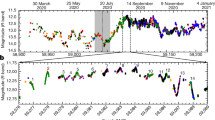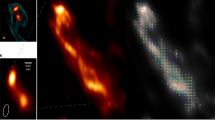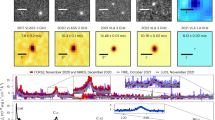Abstract
The extended extragalactic double radio sources—quasars, BL Lac-type-objects (blazars), and radio galaxies—are commonly interpreted as synchrotron sources in which extremely relativistic electrons gyrate in enhanced magnetic fields. The detection of narrow emission bridges between hot spots inside these sources and the centre of an intermediate galaxy has strongly favoured the existence of a continuous power-line feeding the extended source1,3,5. Such beams may be a universal phenomenon occurring in many—if not all—massive galaxies, including our own4. But whereas early interpretations involved low-frequency electromagnetic waves and/or relativistic particle beams, more recent work favoured non-relativistic (β <10−1) (refs 3, 6–8), or mildly relativistic (γ <10) (refs 9–11) bulk velocities for the power supply. In particular, non-relativistic bulk velocities c β have been derived from estimates of the involved kinetic energy densities u and mass densities ρ in the form β≍(2u/ρ)1/2. This can lead to large underestimates of β when ρ is derived from Faraday rotation and depolarization data, because the observed jets are likely to have a two-fluid structure, with light relativistic plasma streaming inside of heavy ‘walls’ of thermal matter, or traversing ‘swarms’ of heavy quasistatic filaments12. We suggest here that these beams consist of extremely relativistic electrons and positrons, of typical Lorentz factor γ ≳102.
This is a preview of subscription content, access via your institution
Access options
Subscribe to this journal
Receive 51 print issues and online access
$199.00 per year
only $3.90 per issue
Buy this article
- Purchase on SpringerLink
- Instant access to full article PDF
Prices may be subject to local taxes which are calculated during checkout
Similar content being viewed by others
References
Butcher, H. R., Van Breugel, W. & Miley, G. K. Astrophys. J. 235, 749 (1980).
Dufour, R. J. & Van den Bergh, S. Astrophys. J. 226, L73 (1978).
Schreier, E. J. et al. Astrophys. J. 234, L39 (1979).
Burton, W. B. & Liszt, H. S. Astrophys. J. 225, 815; 226, 790 (1978).
Rees, M. J. Nature 275, 516 (1978).
Blandford, R. D. & Icke, V. Mon. Not. R. astr. Soc. 185, 527 (1978).
Begelman, M. C., Rees, M. J. & Blandford, R. D. Nature 279, 770 (1979).
Perley, R. A., Willis, A. G. & Scott, J. S. Nature 281, 437 (1979).
Scheuer, P. A. G. & Readhead, A. C. S. Nature 277, 182 (1979).
Blandford, R. D. & Königl, A. Astrophys. Lett. 20, 15 (1979).
Blandford, R. D. & Königl, A. Astrophys. J. 232, 34 (1979).
Kundt, W. & Gopal-Krishna Astrophys. Space Sci. (submitted).
Kundt, W. Astrophys. Space Sci. 62, 335 (1979).
Bridle, A. H. & Fomalont, E. B. Astr. J. 84, 1679 (1979).
Longair, M. S. & Riley, J. M. Mon. Not. R. astr. Soc. 188, 625 (1979).
Banhatti, D. G. Astr. Astrophys. 84, 112 (1980).
Landau, L. D. & Lifshitz, E. M. VI (1966).
Gopal-Krishna & Swarup, G. Mon. Not. R. astr. Soc. 178, 265 (1977).
Simkin, S. M. Astrophys. J. Lett. 222, L55 (1978).
Cotton, W. D. et al. Astrophys. J. Lett. 229, L115 (1979).
Pauliny-Toth, I. 5th European Regional IAU Meet., Liège (1980).
Blandford, R. D., McKee, C. F. & Rees, M. J. Nature 267, 211 (1977).
Reich, W., Stute, U., Reif, K., Kalberla, P. M. W. & Kronberg, P. P. Astrophys. J. Lett. 236, L61 (1980).
Kundt, W. & Krotscheck, E. Astr. Astrophys. 83, 1 (1980).
Kundt, W. An. N.Y. Acad. Sci. 336, 429 (1980).
Leventhal, M., Mac Callum, C. J. & Stang, P. D. Astrophys. J. 225, L11 (1978).
Noerdlinger, P. D. Phys. Rev. Lett. 41, 135 (1978).
Author information
Authors and Affiliations
Rights and permissions
About this article
Cite this article
Kundt, W., Gopal-Krishna Extremely relativistic electron–positron twin-jets form extragalactic radio sources. Nature 288, 149–150 (1980). https://doi.org/10.1038/288149a0
Received:
Accepted:
Issue date:
DOI: https://doi.org/10.1038/288149a0
This article is cited by
-
The physics of E × B-drifting jets
Journal of Astrophysics and Astronomy (2004)



